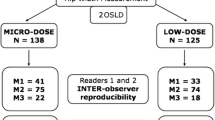Abstract
Objective
To compare the radiation dose, workflow, patient comfort, and financial break-even of a standard digital radiography and a biplanar low-dose X-ray system.
Materials and methods
A standard digital radiography system (Ysio, Siemens Healthcare, Erlangen, Germany) was compared with a biplanar X-ray unit (EOS, EOS imaging, Paris, France) consisting of two X-ray tubes and slot-scanning detectors, arranged at an angle of 90° allowing simultaneous vertical biplanar linear scanning in the upright patient position. We compared data of standing full-length lower limb radiographs and whole spine radiographs of both X-ray systems.
Results
Dose–area product was significantly lower for radiographs of the biplanar X-ray system than for the standard digital radiography system (e.g. whole spine radiographs; standard digital radiography system: 392.2 ± 231.7 cGy*cm2 versus biplanar X-ray system: 158.4 ± 103.8 cGy*cm2). The mean examination time was significantly shorter for biplanar radiographs compared with standard digital radiographs (e.g. whole spine radiographs: 449 s vs 248 s). Patients’ comfort regarding noise was significantly higher for the standard digital radiography system. The financial break-even point was 2,602 radiographs/year for the standard digital radiography system compared with 4,077 radiographs/year for the biplanar X-ray unit.
Conclusion
The biplanar X-ray unit reduces radiation exposure and increases subjective noise exposure to patients. The biplanar X-ray unit demands a higher number of examinations per year for the financial break-even point, despite the lower labour cost per examination due to the shorter examination time.



Similar content being viewed by others
References
Dumas R, Aissaoui R, Mitton D, Skalli W, de Guise JA. Personalized body segment parameters from biplanar low-dose radiography. IEEE Trans Biomed Eng. 2005;52:1756–63.
Dubousset J, Charpak G, Dorion I, et al. A new 2D and 3D imaging approach to musculoskeletal physiology and pathology with low-dose radiation and the standing position: the EOS system. Bull Acad Natl Med. 2005;189:287–300.
Illés T, Tunyogi-Csapó M, Somoskeöy S. Breakthrough in three-dimensional scoliosis diagnosis: significance of horizontal plane view and vertebra vectors. Eur Spine J. 2011;20:135–43.
Labelle H, Aubin CE, Jackson R, Lenke L, Newton P, Parent S. Seeing the spine in 3D: how will it change what we do? J Pediatr Orthop. 2011;31:S37–45.
Després P, Beaudoin G, Gravel P, de Guise JA. Physical characteristics of a low-dose gas microstrip detector for orthopedic x-ray imaging. Med Phys. 2005;32:1193–204.
Deschênes S, Charron G, Beaudoin G, et al. Diagnostic imaging of spinal deformities: reducing patients radiation dose with a new slot-scanning X-ray imager. Spine. 2010;35:989–94.
Parry CK, Chu RY, Eaton BG, Chen CY. Measurement of skin entrance exposure with a dose-area-product meter at chest radiography. Radiology. 1996;201:574–5.
Uebersax JS. Likert scales: dispelling the confusion. Statistical Methods for Rater Agreement website. 2006. Available via http://john-uebersax.com/stat/likert.htm. Accessed 6 November 2012.
Illers H, Buhr E, Hoeschen C. Measurement of the detective quantum efficiency (DQE) of digital X-ray detectors according to the novel standard IEC 62220–1. Radiat Prot Dosim. 2005;114:39–44.
Korner M, Weber CH, Wirth S, Pfeifer KJ, Reiser MF, Treitl M. Advances in digital radiography: physical principles and system overview. Radiographics. 2007;27:675–86.
Martin CJ. Radiation dosimetry for diagnostic medical exposures. Radiat Prot Dosim. 2008;128:389–412.
Svane G, Azavedo E, Lindman K, et al. Clinical experience of photon counting breast tomosynthesis: comparison with traditional mammography. Acta Radiol. 2011;52:134–42.
Liedenbaum MH, Denters MJ, de Vries AH, et al. Low-fiber diet in limited bowel preparation for CT colonography: influence on image quality and patient acceptance. Am J Roentgenol. 2010;195:W31–7.
Gonçalves A, Wiezel VG, Gonçalves M, Hebling J, Sannomiya EK. Patient comfort in periapical examination using digital receptors. Dentomaxillofac Radiol. 2009;38:484–8.
Winter L, Glücker T, Steimann S, et al. Feasibility of dynamic MR-hysterosalpingography for the diagnostic work-up of infertile women. Acta Radiol. 2010;51:693–701.
Berná-Mestre JD, Berná-Serna JD, Aparicio-Mesón M, Canteras-Jordana M. Urethrography in men: conventional technique versus clamp method. Radiology. 2009;252:240–6.
McKenna C, Wade R, Faria R, et al. EOS 2D/3D X-ray imaging system: a systematic review and economic evaluation. Health Technol Assess. 2012;16:1–188.
Morvan G, Mathieu P, Vuillemin V, et al. Standardized way for imaging of the sagittal spinal balance. Eur Spine J. 2011;20:602–8.
Than P, Szuper K, Somoskeöy S, Warta V, Illés T. Geometrical values of the normal and arthritic hip and knee detected with the EOS imaging system. Int Orthop. 2012;36:1291–7.
Sabourin M, Jolivet E, Miladi L, Wicart P, Rampal V, Skalli W. Three-dimensional stereoradiographic modeling of rib cage before and after spinal growing rod procedures in early-onset scoliosis. Clin Biomech. 2010;25:284–91.
Ohl X, Stanchina C, Billuart F, Skalli W. Shoulder bony landmarks location using the EOS® low-dose stereoradiography system: a reproducibility study. Surg Radiol Anat. 2009;32:153–8.
Schlatterer B, Suedhoff I, Bonnet X, Catonne Y, Maestro M, Skalli W. Skeletal landmarks for TKR implantations: evaluation of their accuracy using EOS imaging acquisition system. Orthop Traumatol Surg Res. 2009;95:2–11.
Lazennec JY, Rousseau MA, Rangel A, et al. Pelvis and total hip arthroplasty acetabular component orientations in sitting and standing positions: measurements reproducibility with EOS imaging system versus conventional radiographies. Orthop Traumatol Surg Res. 2011;97:373–80.
Buck FM, Guggenberger R, Koch PP, Pfirrmann CW. Femoral and tibial torsion measurements with 3D models based on low-dose biplanar radiographs in comparison with standard CT measurements. Am J Roentgenol. 2012;199:W607–12.
Thelen P, Delin C, Folinais D, Radier C. Evaluation of a new low-dose biplanar system to assess lower-limb alignment in 3D: a phantom study. Skeletal Radiol. 2012;41:1287–93.
Sutter R, Pfirrmann CW, Espinosa N, Buck FM. Three-dimensional hindfoot alignment measurements based on biplanar radiographs: comparison with standard radiographic measurements. Skeletal Radiol. 2013;42:493–98. .
Conflict of interests
The authors declare that they have no conflict of interest.
Author information
Authors and Affiliations
Corresponding author
Electronic supplementary material
ESM 1
(PDF 198 kb)
Rights and permissions
About this article
Cite this article
Dietrich, T.J., Pfirrmann, C.W.A., Schwab, A. et al. Comparison of radiation dose, workflow, patient comfort and financial break-even of standard digital radiography and a novel biplanar low-dose X-ray system for upright full-length lower limb and whole spine radiography. Skeletal Radiol 42, 959–967 (2013). https://doi.org/10.1007/s00256-013-1600-0
Received:
Revised:
Accepted:
Published:
Issue Date:
DOI: https://doi.org/10.1007/s00256-013-1600-0




